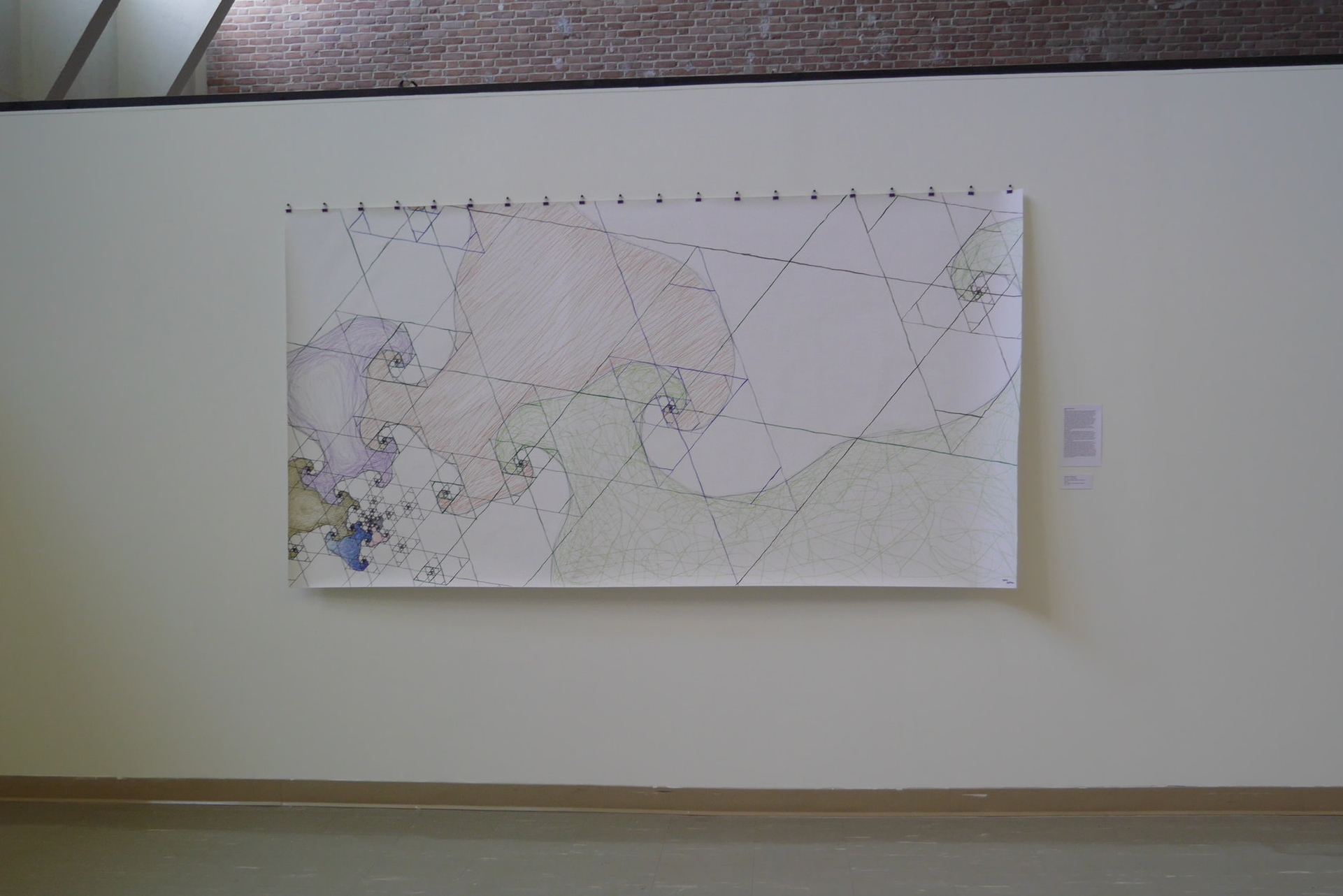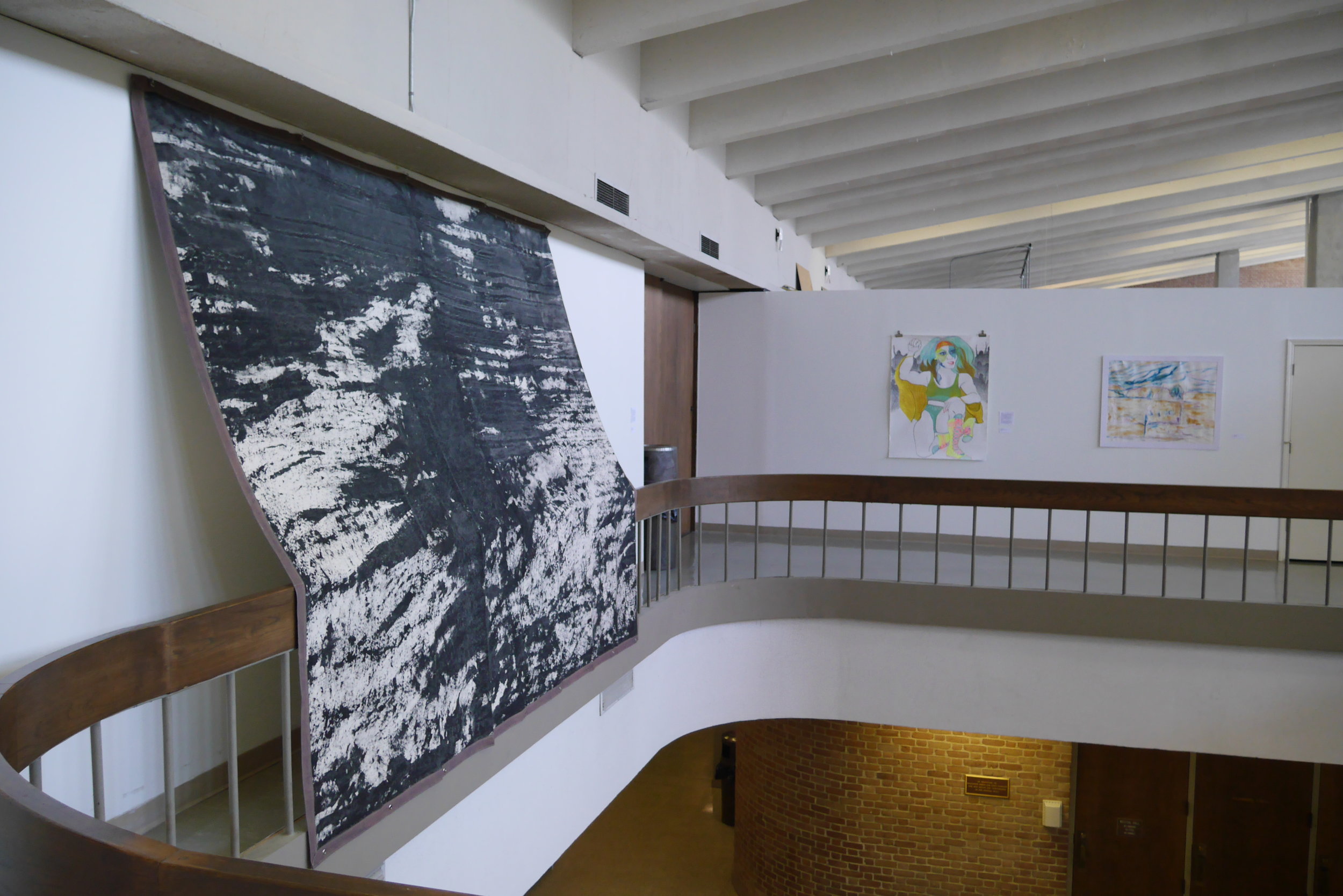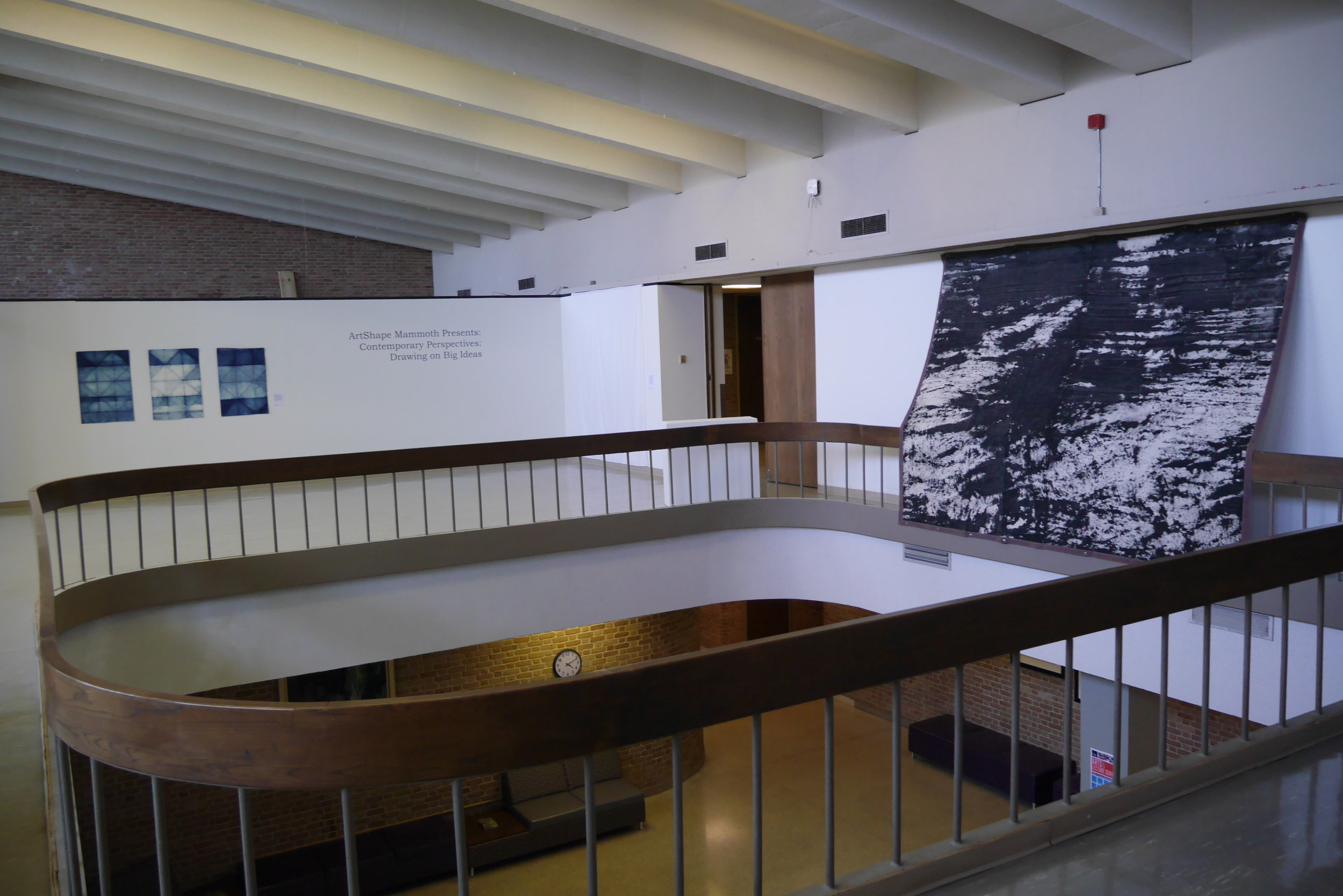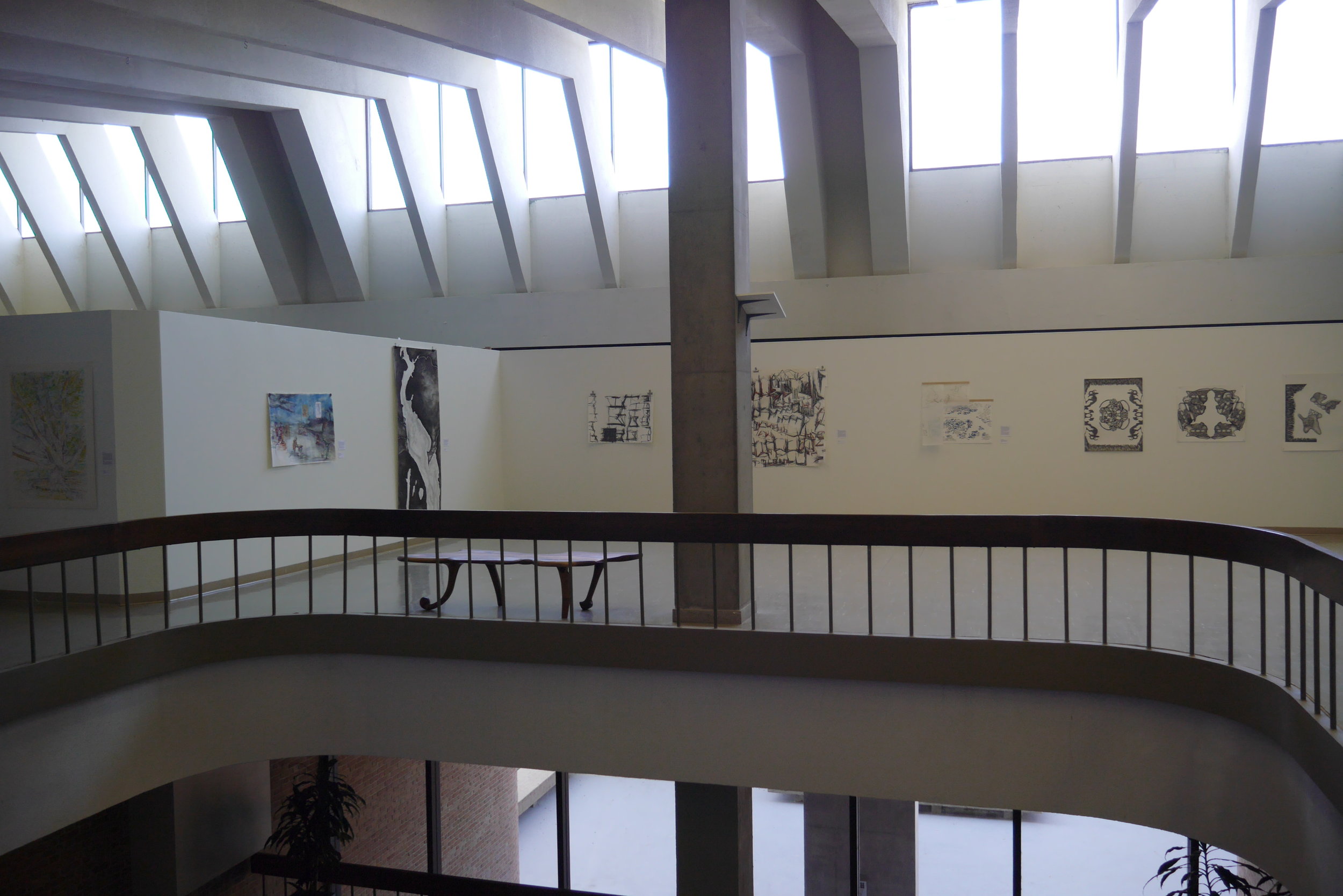Contemporary Perspectives: Drawing on Big Ideas
Lewis Art Gallery, Millsaps College
September 26th - October 26th, 2016
ArtShape Mammoth presents large-scale drawings from cutting-edge contemporary artists. Featuring David Alban, Kristi Arnold, Cori Champagne, Liz Ensz, Lindsey French, Seth Goodman, Joan Harmon, Joshua Hosterman, Aimee Hertog, Justine Johnson, and Sarah Magida.
Organized by ASM Artist Kristen Tordella-Williams, and Curated by Lewis Art Gallery Director, Matthew Holl.

Joan Harmon, Hudson River Series #3
charcoal on paper
90” X 44”
I have always been intrigued by the flow of water and the forms moving water create. As a resident of the shores of the Hudson for over 20 years, I have developed a particularly intimate relationship with the river. This body of work is my homage- coming from a desire for a new landscape drawing informed by Google Earth and the ancient art of mapping.

Justine Johnson, Open Cluster I-III
Japanese paper, indigo
63cm x 92cm
My work is diverse but always closely linked to process and understanding of materials including their history and connection to culture. Currently I am exploring ancient method (organic sugar fermentation Indigo) and plant dyeing techniques and consequent resonance in culture, nature, space and time. As an artist I don’t recognise limits.
I have always felt drawing to be a fundamental element to my practice. My drawings are created by the process of folding paper and submerging in a natural indigo vat. The folds create lines that link up and connect to each other. With each dip patterns are formed and depth is reached with the many shades of indigo; an ancient colour of humanity.

Aimee Hertog, Golden Wall
mixed media on paper
42" x 37"
My drawings are “back to basics” for me, both in the subject matter which are traditional landscapes presented here and the media, which is drawing. In them I have rediscovered the foundation of my art. Clean, pure drawing is essential to any visual expression but is sometimes forgotten in the pursuit of technological advances applied to art. This meditative and disciplined project has reinforced my practice.

Aimee Hertog, Tree
colored pencil on paper
45" x 33"

Sarah Magida, Reach Out
ink, pencil, colored pencil
30" x 50"
The lady wrestler series, inspired from the documentary G.L.O.W., The Gorgeous Ladies of Wrestling, represent a much more commanding presence, while maintaining an attention to color and costume. They are the perfect combination of the masculine and feminine in larger than life form. The women are proud, direct and well dressed. Often executed in ink and other drawing mediums they may shock and provide a bit of fun for the viewer while creating an engaging dialogue.

Kristi Arnold, Grotesque Study 1-6
graphite on Fabriano
28” x 37”
Today the Grotesque is associated with the horrific, the repulsive, the ugly, and the distorted. Our society craves disfiguration, evidenced by deformed rubber Halloween masks, tales of monsters, both real and imaginary, and the proliferation of horrific acts by characters in film and literature. However, the grotesque by origin, described an ornamental style of Renaissance painting that embodied not the ugly, but the beautiful. By positioning the Grotesque within a theoretical framework, as in a state of flux, a ‘flip-flopping’ of opposing adjectives and forms, I explore contrasting ideas such as beauty/ugliness, representation/abstraction, order/disorder and the poetic/horrific as well as the connection between contemporary horror films, character masks and the tragic comedy of the Commedia dell'arte.
At the same time, the grotesque signifies a paradox, a matrix for the ‘in-between,’ always in a state of transformation. The main objective of Grotesque Studies explores this concept through distortion, transformation, dark humor, absurdity and the play between positive and negative space. I specifically use both recognizable and unrecognizable forms, repeating them until distorted, which in turn transforms the shape from its original context. Similar to the Rorschach and Thomas Kuhn’s paradigm shift theory, the shapes resemble certain icons, yet they are not completely apparent; instead, they are interchangeable. The symmetrical compositions echo those found within the early Renaissance and Neronian grotesque frescoes as well as challenge the Vitruvian ideal of symmetry as beauty. By exploiting these situations through the juxtaposition of opposites, I hope to incite ideas that contend with a dystopian and utopian world, where the boundaries between fact and fiction, beauty and ugliness are closely bound, where the grotesque exists.

Cori Champagne, The Jungle
marker and sharpie on paper and trace, wood and plywood supports
35.5” x 33”
“The Jungle” is based on the migrant camp of 10,000+ outside of Calais, France of the same name. The camp has proximity to the EuroTunnel and ferries traveling to the UK, and many refugees undertake dangerous attempts to reach England from these entry points. The drawing depicts a portion of the camp, with the iconic blue tarp enclosures, a larger view of the main areas of interest, and maps showing the distance to travel to the Tunnel., and to England. France recently committed to dismantle the camp completely, after repeated attempts to close it down.

David Alban, Fragments 1
graphite on paper
My recent work has centered on teeth, and mandibles coming from some industrial strength dental work I endure. Teeth are very prominent in all of the animal kingdom. They function as tools and weapons. Much attention is paid to them visually. Our culture assigns an utmost importance to their image. Likewise, the mandible is very prominent. It is the first bone to develop in utero. I want to them to be large enough to remove you from the experience in front of the mirror we all have of picking, brushing, and flossing. When fabricating I am reminded of the studies I have done in the anatomy lab and the discovery an archeologist must feel in the field.

David Alban, Fragments 2
graphite on paper
55" x 72"

Joshua Hosterman, (2:1:2:1...):(3:6:3:6...) Or, Sober September's Stripes & Swirls
ink, marker, and pencil on paper
4.5’ x 9’
My goal was to create a pattern that would grow and shrink infinitely at the same time in both directions. I guess I found that there are more than two directions. My geometry continues to shrink as it grows, but as it shrinks, it only shrinks. I find this to be an apt metaphor for life. Isn't the whole function of life to struggle to grow as more and more parts of us inevitably shrink? So, I suppose I must create a new pattern that does actually grow as it shrinks.
As I began mapping the organic curves onto the geometry, these sort of double-vagina-uterus-monsters started to emerge and fill the space. This got me thinking about two penises entering the same female and tickling each other off inside as their heads bump and rub. I've been asked about whether the discussion of twat monsters and jizz mixing is pertinent to this piece. My position is that, as an honest glimpse into the mind of the artist and into the culture from which he grows, it is. Growing up, I learned about sex from the 2 Live Crew and Focus On The Family. I've made some progress since those days, but I'm still kinda confused. Our culture is still plagued by religious guilt and corporate sexual harassment. Let's talk about it when it comes to mind. It'll be okay;)

Seth Goodman, The Color of Sweat
mixed-media (gouache, charcoal, oil pencils)
30” x 45”
This drawing is a part of the body of work I’ve made on my recent sabbatical in south Florida. This drawing in particular, is about the overt class and wealth disparity I found in south Florida. I became intimately familiar with a long-term road construction project on highway A1A and I used this as a conceptual starting point to investigate the intersection of wealth, class, and race.

Lindsey french, ‘When you were mine’ by Prince
urushiol pressed from poison ivy, bedsheet
90" x 120"
I painted my nails yellow today, a buttercup yellow that needed 3 coats because the first two were bumpy from the thin layer of pollen that covered everything, my computer and the table and even the surface of my fingernails, a thin coating of sex on my entire body. I’m not allergic to pollen but I am allergic to poison ivy, and my skin hardens where urushiol makes contact into bumps and lines. When it first arrives it is tenderly itchy. I feel it with my other skin, feeling it as something more external than the skin not undergoing a reaction. It takes 24 to 48 hours for skin to react to urushiol. Prince wrote “You didn’t have the decency / to change the sheets.” If you don’t wash your sheets after coming into contact with poison ivy, you risk continued re-exposure.

Liz Ensz, A Topographic Portrait of a Disappearing Site
frottage pigment on canvas
9' x 12'
A Topographic Portrait of a Disappearing Site is a frottage drawing of a street in my neighborhood. There are potholes, street has been scraped, repaired, patched, and there has been so much degradation from wear that large rocks are exposed in the no longer smooth asphalt surface. The scale, textures, and vertical display of this work ground it in geological references, the striped strata and textured field bring a sense of time to this artifact. As the neighborhood continues to change, and the road degrades or gets resurfaced, this work is a portrait of the site in the precise moment it was made.













